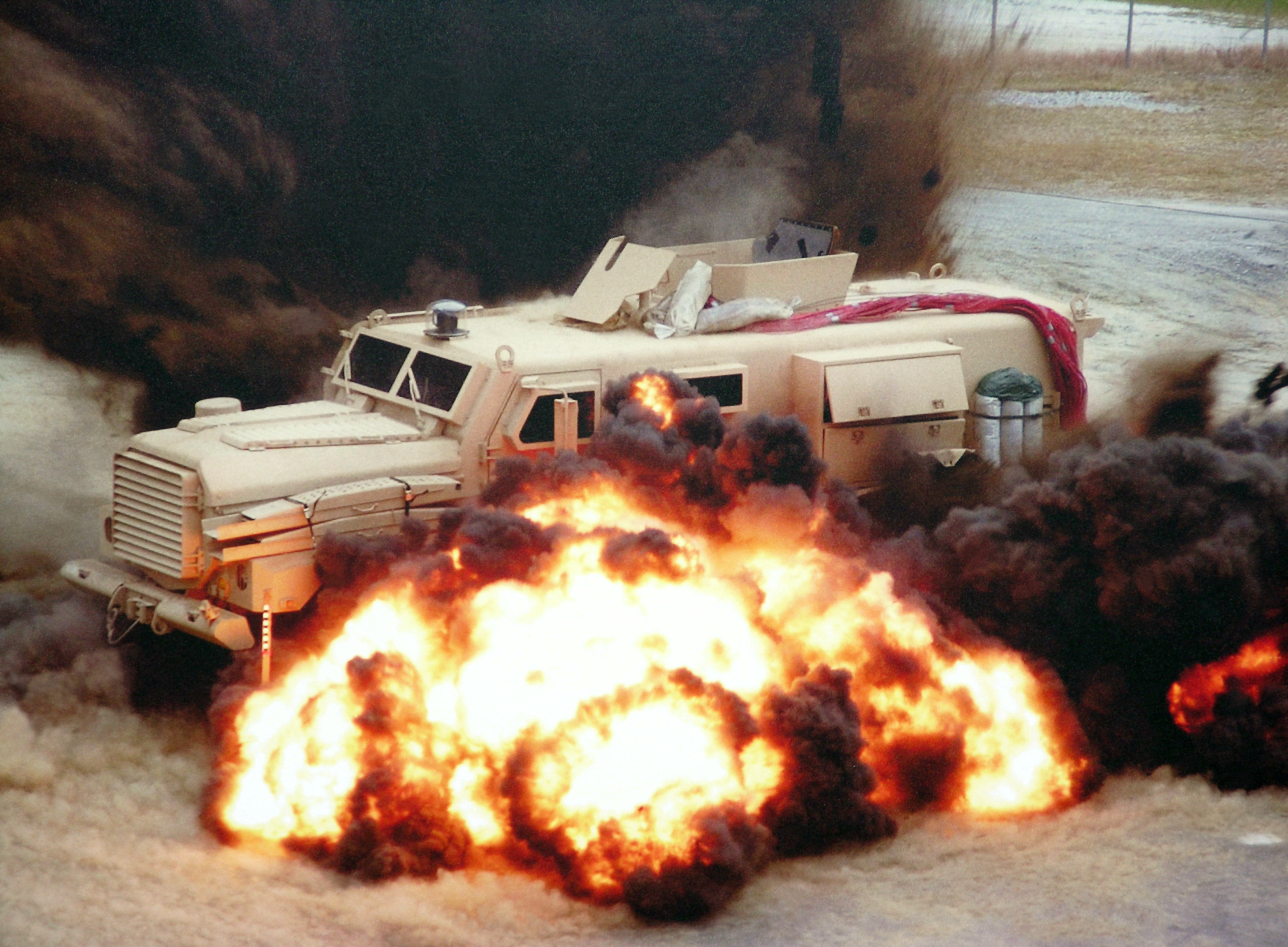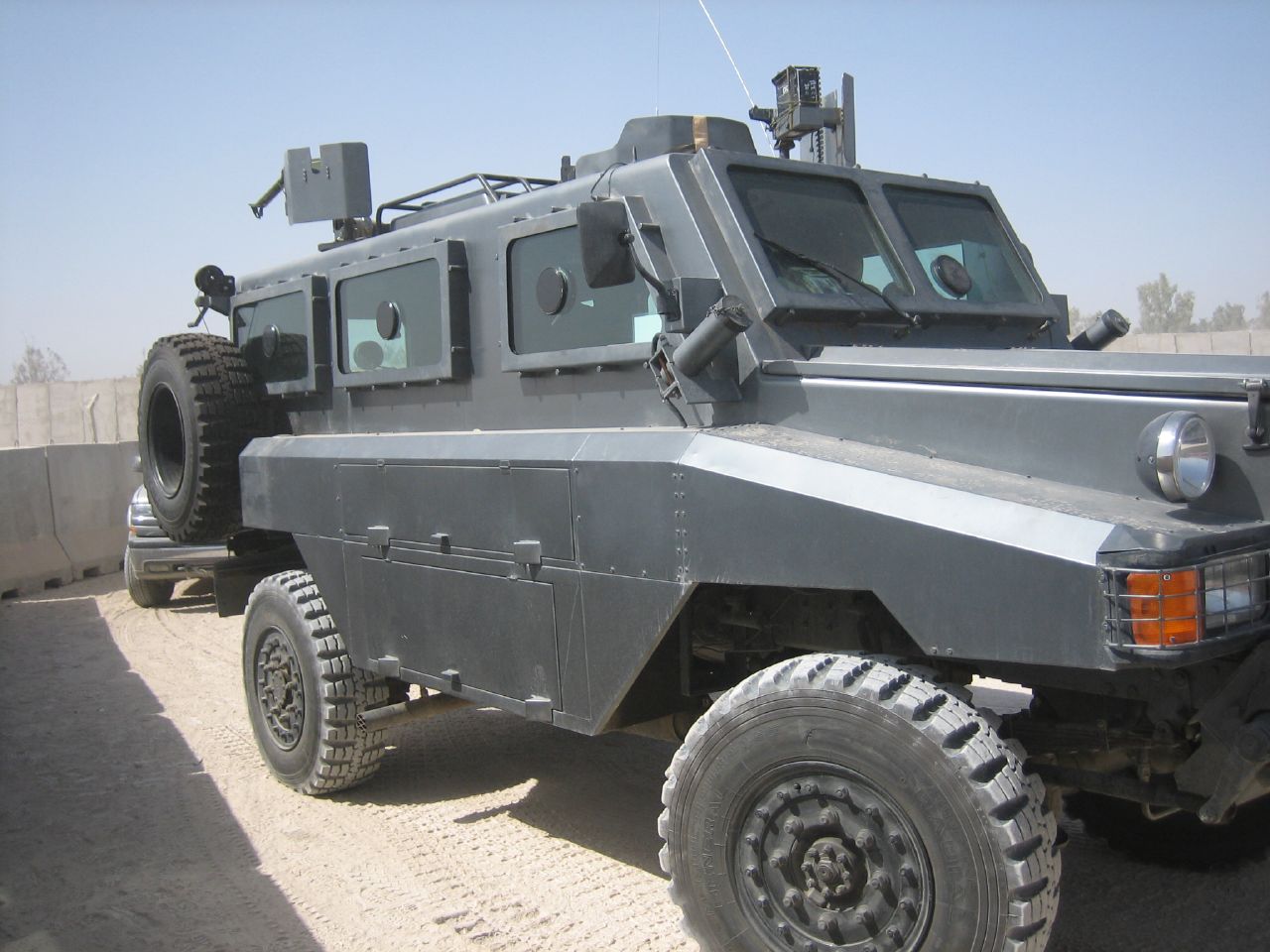|
RG-31
The RG-31 Nyala is a 4×4 multi-purpose mine-resistant ambush protected infantry mobility vehicle manufactured in South Africa by Land Systems OMC (the division of Denel SOC LTD, located in Benoni, South Africa) and in Turkey by FNSS Defence Systems. It is based on the Mamba APC of TFM Industries. The RG-31 has become the multi-purpose vehicle of choice of the UN and other peacekeeping and security forces. It is finding favour with non-governmental organisations requiring a vehicle with a non-aggressive appearance to protect their personnel against land mines. Design The RG-31 is built from a V-shaped all-steel welded armor monocoque hull and high suspension, typical of South African mine protected vehicles, providing excellent small-arms and mine blast protection. The vehicle is designed to resist a blast equivalent to two TM-57 anti-tank mines detonating simultaneously. The RG-31 is classified by the United States Department of Defense as a category 1 Mine Resistan ... [...More Info...] [...Related Items...] OR: [Wikipedia] [Google] [Baidu] |
RG-31
The RG-31 Nyala is a 4×4 multi-purpose mine-resistant ambush protected infantry mobility vehicle manufactured in South Africa by Land Systems OMC (the division of Denel SOC LTD, located in Benoni, South Africa) and in Turkey by FNSS Defence Systems. It is based on the Mamba APC of TFM Industries. The RG-31 has become the multi-purpose vehicle of choice of the UN and other peacekeeping and security forces. It is finding favour with non-governmental organisations requiring a vehicle with a non-aggressive appearance to protect their personnel against land mines. Design The RG-31 is built from a V-shaped all-steel welded armor monocoque hull and high suspension, typical of South African mine protected vehicles, providing excellent small-arms and mine blast protection. The vehicle is designed to resist a blast equivalent to two TM-57 anti-tank mines detonating simultaneously. The RG-31 is classified by the United States Department of Defense as a category 1 Mine Resistan ... [...More Info...] [...Related Items...] OR: [Wikipedia] [Google] [Baidu] |
MRAP
Mine-Resistant Ambush Protected (MRAP; ) is a term for United States Armed Forces, United States military light tactical vehicles produced as part of the MRAP program that are designed specifically to withstand improvised explosive device (IED) attacks and ambushes. The United States Department of Defense MRAP program began in 2007 as a response to the increased threat of IEDs during the Iraq War. From 2007 until 2012, the MRAP program deployed more than 12,000 vehicles in the Iraq War, War in Iraq and War in Afghanistan (2001–present), War in Afghanistan. Production of MRAP vehicles officially ended in 2012. This was followed by the Oshkosh M-ATV, MRAP All Terrain (M-ATV) vehicle. In 2015, Oshkosh Corporation was awarded a contract to build the Oshkosh L-ATV as the Joint Light Tactical Vehicle, a lighter mine-resistant vehicle to replace the Humvee in combat roles and supplement the M-ATV. History Light armored vehicles designed specifically to resist land mines were f ... [...More Info...] [...Related Items...] OR: [Wikipedia] [Google] [Baidu] |
Mamba APC
The Mamba is a South African armoured personnel carrier designed for internal security purposes. It was developed during the late 1980s to replace the Buffel in service with the South African military and security forces. The first models were built on a 4X2 Toyota Dyna chassis, which was subsequently replaced in production around 1994 by a more reliable Unimog chassis. All marks of the Mamba were designed to be mine-resistant and blastproof. Development history Mamba Mk1 The South African Army issued a requirement for a new armoured vehicle in 1987 capable of a wide variety of roles, namely border protection and internal security. The Mamba Mk1 was developed the following year and utilised the chassis of a Toyota Dyna 4X2 truck. A number were accepted into service between 1990 and 1994. Subsequent marks After 1994, the Mamba utilised a Unimog truck chassis for better off-road performance and ground clearance. The first units were derived from surplus Buffel vehicles. Its V-sh ... [...More Info...] [...Related Items...] OR: [Wikipedia] [Google] [Baidu] |
Letterkenny Army Depot
Letterkenny Army Depot (originally Letterkenny Ordnance Depot), the Center of Industrial and Technical Excellence (CITE) for Air Defense and Tactical Missile Systems, was established in 1942. The Depot is under the command structure of the U.S. Army Aviation and Missile Command (AMCOM). The facilities at Letterkenny are used to conduct maintenance, modification, storage, and demilitarization operations on tactical missiles and ammunition. Located primarily in Letterkenny Township and extending into Greene Township and Hamilton Township, all in Franklin County, Pennsylvania, just northwest of the borough of Chambersburg, the Depot consists of nearly 18,000 acres (71 km²). It is the largest employer in Franklin County, Pennsylvania, and adds over one-quarter of a billion dollars annually to the region's economy. Letterkenny has unique tactical missile repair capabilities repairing a variety of Department of Defense (DoD) missile systems, including the MIM-104 PATRIOT mis ... [...More Info...] [...Related Items...] OR: [Wikipedia] [Google] [Baidu] |
Infantry Mobility Vehicle
An infantry mobility vehicle (IMV) is a wheeled armored personnel carrier (APC) serving as a military patrol, reconnaissance or security vehicle. Examples include the ATF Dingo, Iveco LMV, Oshkosh M-ATV, AMZ Dzik, AMZ Tur, Mungo ESK, and Bushmaster IMV. This term also applies to those vehicles fielded as part of the MRAP program. IMVs were developed in response to the threats of modern warfare, with an emphasis on crew protection and mine-resistance. Similar vehicles existed long before the term IMV was coined, such as the French VAB and South African Buffel. The term is coming more into use to differentiate light 4x4 wheeled APCs from the traditional 6x6 and 8x8 wheeled APCs. The up-armored M1114 Humvee variant can be seen as an adaptation of the unarmoured Humvee to serve in the IMV role. Etymology In 1994, the Australian Department of Defence identified the need to mobilise infantry through the acquisition of unprotected and protected vehicles. This eventually ... [...More Info...] [...Related Items...] OR: [Wikipedia] [Google] [Baidu] |
Land Systems OMC
Land Systems OMC is a South African company that produces a range of armoured vehicles which have been successfully exported and are in service with, amongst others, the U.S., Canadian and South African militaries. It is a division of Denel SOC LTD, located in Benoni, Gauteng. The OMC segment of the name is the initialism under which the Olifant Manufacturing Co. of South Africa was most commonly known during its existence. The original company was established specifically for the task of creating the Olifant tank for the South African Army. Ownership Reunert OMC's existence as an independent company was short-lived however, and early into its life it was taken over by Reunert, which subsequently turned it into a division called Reumech OMC. It was under this name that OMC saw its most prolific level of vehicle development, as combat operations during the Angolan Bush War necessitated a greater need for vehicle systems capable of being integrated with the very swift, flexible, o ... [...More Info...] [...Related Items...] OR: [Wikipedia] [Google] [Baidu] |
Infantry Mobility Vehicle
An infantry mobility vehicle (IMV) is a wheeled armored personnel carrier (APC) serving as a military patrol, reconnaissance or security vehicle. Examples include the ATF Dingo, Iveco LMV, Oshkosh M-ATV, AMZ Dzik, AMZ Tur, Mungo ESK, and Bushmaster IMV. This term also applies to those vehicles fielded as part of the MRAP program. IMVs were developed in response to the threats of modern warfare, with an emphasis on crew protection and mine-resistance. Similar vehicles existed long before the term IMV was coined, such as the French VAB and South African Buffel. The term is coming more into use to differentiate light 4x4 wheeled APCs from the traditional 6x6 and 8x8 wheeled APCs. The up-armored M1114 Humvee variant can be seen as an adaptation of the unarmoured Humvee to serve in the IMV role. Etymology In 1994, the Australian Department of Defence identified the need to mobilise infantry through the acquisition of unprotected and protected vehicles. This eventually ... [...More Info...] [...Related Items...] OR: [Wikipedia] [Google] [Baidu] |
Tonne
The tonne ( or ; symbol: t) is a unit of mass equal to 1000 kilograms. It is a non-SI unit accepted for use with SI. It is also referred to as a metric ton to distinguish it from the non-metric units of the short ton ( United States customary units), and the long ton ( British imperial units). It is equivalent to approximately 2204.6 pounds, 1.102 short tons, and 0.984 long tons. The official SI unit is the megagram (symbol: Mg), a less common way to express the same mass. Symbol and abbreviations The BIPM symbol for the tonne is t, adopted at the same time as the unit in 1879.Table 6 . BIPM. Retrieved on 2011-07-10. Its use is also official for the metric ton in the United States, having been adopted by the United States |
FNSS Defence Systems
FNSS Savunma Sistemleri A.Ş. ( en, FNSS Defence Systems A.Ş.) is a Turkish defense manufacturer founded in 1988. It is owned 51% by Nurol Holding of Turkey and 49% by British–American firm BAE Systems Inc., and operates facilities located in Gölbaşı, Ankara. FNSS was founded as a joint venture between FMC Corporation and Nurol Holding as FMC Nurol Savunma Sanayii A.Ş. It is a major supplier of tracked and wheeled armored vehicles and weapon systems for the Turkish Armed Forces and Allied Armed Forces. Products Tracked Armored Vehicles * ACV-AAPC (advanced armored personnel carrier) — with a one-man turret with a 12.7 mm machine gun and ab7.62 mm machine gun; 13 troops carried. * ACV-AIFV ** AIFV with FMC EWS (assembled by DAF Special Products) turret with a 25 mm Oerlikon Contraves 25 mm cannon and a coaxial 7.62 mm machine gun ** AIFV with Giat Dragar turret with a 25 mm M811 cannon and a coaxial 7.62 mm machine gun. * ACV-A ... [...More Info...] [...Related Items...] OR: [Wikipedia] [Google] [Baidu] |
Mortar Carrier
A mortar carrier, or self-propelled mortar, is a self-propelled artillery piece in which a mortar is the primary weapon. Simpler vehicles carry a standard infantry mortar while in more complex vehicles the mortar is fully integrated into the vehicle and cannot be dismounted from the vehicle. Mortar carriers cannot be fired while on the move and some must be dismounted to fire. Evolution The mortar carrier has its genesis in the general mechanisation and motorisation of infantry in the years leading up to World War II. To move an infantry mortar and its crew various methods were developed, for example mounting the mortar on a wheeled carriage for towing behind a light vehicle, attaching the mortar and its permanently fixed baseplate to the rear of a vehicle — the entire assembly hinging from the horizontal for travel and to the vertical to fire, simply transporting the disassembled mortar (tube, baseplate and bipod) its crew and mortar bombs by truck or half-track. Provisi ... [...More Info...] [...Related Items...] OR: [Wikipedia] [Google] [Baidu] |
Armoured Personnel Carrier
An armoured personnel carrier (APC) is a broad type of armoured military vehicle designed to transport personnel and equipment in combat zones. Since World War I, APCs have become a very common piece of military equipment around the world. According to the definition in the Treaty on Conventional Armed Forces in Europe, an APC is "an armoured combat vehicle which is designed and equipped to transport a combat infantry squad and which, as a rule, is armed with an integral or organic weapon of less than 20 millimetres calibre." Compared to infantry fighting vehicles (IFVs), which are also used to carry infantry into battle, APCs have less armament and are not designed to provide direct fire support in battle. Infantry units which travel in APCs are known as mechanized infantry. Some militaries also make a distinction between infantry units which use APCs and infantry units which use IFVs, with the latter being known as armoured infantry in such militaries. History The genesis ... [...More Info...] [...Related Items...] OR: [Wikipedia] [Google] [Baidu] |





